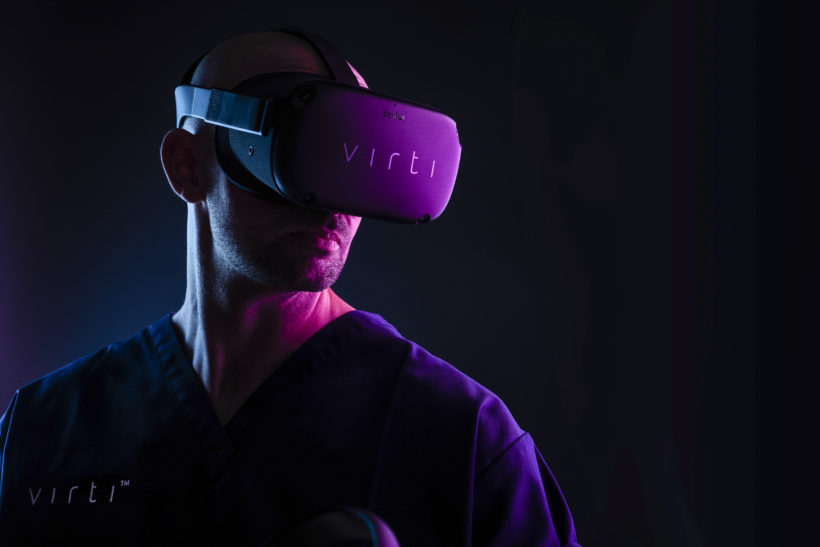Facebook’s Mark Zuckerberg made headlines this year with his ambitious plans to build a metaverse, a world in which social and professional interactions are mediated by immersive digital technologies. But away from the front pages, these technologies are already being enthusiastically adopted by forward-thinking companies.
And while the past year has seen a plethora of similarly innovative workplace tools wax and wane in popularity, as 2021 draws to a close it’s immersive technologies like virtual reality (VR) and augmented reality (AR) that are on a trajectory of exponential growth.
But why is immersive tech being called 2022’s must-have business tool? And how exactly can your company leverage VR and AR for maximum impact – from onboarding to training, conferencing and well-being? Let’s dive into these questions below.
Free Download: The Definitive Guide to Technology for Startups
What are immersive technologies?
Immersive technology is an umbrella term referring to tech with the capacity to integrate the real and virtual world, including:
- Virtual reality (VR), which immerses users in a fully artificial digital environment or 360-degree video.
- Augmented reality (AR), which overlays virtual objects onto a real-world environment.
Typically, users access the platforms on which VR and AR content is hosted from mobile phones, laptops, tablets or headsets. This is significant because it removes barriers of time and space. Employees can access the content whenever and wherever they want!
How can immersive tech be used in the workplace?
- Onboarding
With the current competition for new talent likely to intensify even further in 2022, organizations can’t afford to be complacent when it comes to onboarding new recruits. Luckily, when it comes to upping your onboarding game, immersive technologies can deliver that much-needed edge on the competition.
Let’s look at the four main objectives that onboarding programs are typically structured around:
- Alignment with company mission, values and culture.
- End-to-end understanding of the product or service.
- Understanding the customer or client and their needs.
- Learning how to follow or use internal processes or systems.
All of these can be achieved on a VR platform, where onboarding staff are immersed in a fully digital environment and 360-degree video when appropriate.
The bespoke learning content, grouped into modules or courses, can be easily shared with an unlimited number of remote or hybrid employees. Managers and mentors can monitor the progress of new hires (and spot any areas where additional support is needed) by looking at the data generated by the platform.
- Training and upskilling
Once you’ve onboarded your team, the retention battle begins! The first thing to consider is that 2022’s workforce doesn’t consider skill development a workplace bonus; they consider it a make-or-break factor. So if you want to retain your best employees, you need to offer them the best opportunities for professional growth and talent development.

VR employee training is currently being pioneered by major global companies — from Walmart to Accenture and Bank of America — and studies have shown that immersive simulation training can improve learning outcomes by 76% and knowledge retention by 230%.
This is because VR simulations provide a low-pressure, effective, scalable and consistent way to train, while also furnishing learners with meaningful, data-backed feedback on their performance.
It’s not just complex technical procedures (surgery, for example) that can be learned; VR platforms are well suited to soft skills training, too. Leading immersive tech platforms support the re-creation of the stress and emotion of challenging scenarios — such as client negotiations — while also capturing and analyzing data on trainee decisions and behavioral response.
In short, immersive technologies can help employers to deliver the sector-leading internal training that will become essential to retaining staff and improving team performance in 2022.
- Mental health and well-being support.
Excellent onboarding and training are two ways to build a happy workforce, but in 2022, investment in employee well-being is equally paramount. With 42% of UK employees reporting that their well-being has been negatively impacted at work, a robust support system must be a priority for every employer.
Providing employees with access to counselling, mindfulness programs and resilience training are all popular and proven well-being initiatives. However, these have high barriers to access — expense and time being just two.
When it was reported that Facebook were handing out Oculus VR headsets to all of their employees as part of their health and well-being package, HR teams around the world began to sit up and think about the potential of VR tech for mental health support.
VR mindfulness and resilience training courses are now exploding in popularity, with research backing up anecdotal reports of their impact. And when it comes to therapy, it’s looking increasingly likely that making an appointment for your avatar to “meet” a therapist in a virtual environment will soon become completely normal. All indicators suggest that it won’t be long before VR well-being packages become a must-have staff perk. Will your business get ahead of the curve?
- Virtual events How many of us can honestly say that we get excited by the thought of another webinar or e-conference? The novelty of online-only events wore off very quickly during the pandemic, yet it has become difficult to justify the expense and inconvenience of organizing in-person events.
One response to this dilemma came from trailblazing fashion house Balenciaga, who staged its dystopian autumn/winter 2021 collection as a virtual reality runway show and sent Oculus glasses to 330 guests worldwide. The masterfully executed event showcased how VR can be used to elevate events and excite guests:
- The novelty of the experience helps to generate interest.
- Barriers of distance and cost can be eliminated.
- Entirely COVID-secure.
- Inbuilt data collection tools allow tracking of participant engagement and participation.
- Instant, real-time feedback can be collected from attendees.
- Multimedia resources can be instantly shared.
- Use of avatars helps with building meaningful virtual relationships.
With so many advantages, it’s well worth evaluating your 2022 events calendar to identify opportunities for migration to VR-first delivery.
Looking ahead to the future
No longer the sole preserve of gamers, immersive technologies are only going to become more widely used in 2022. They’re already proving their worth for employee onboarding, skills training, conferencing and well-being provision, but it seems that the sky really is the limit of their potential. With so many companies already betting big on VR, there’s never been a more exciting time to take your first steps with the tech.






